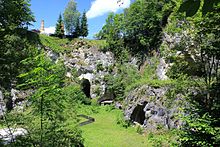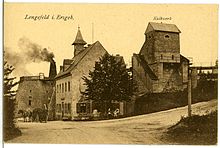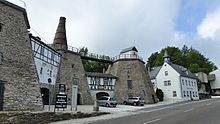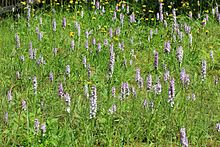Lengefeld lime works
The lengefeld lime works was a lime - mine southwest of the Saxon town of Pockau-Lengefeld in the Erzgebirge . It was the last mine in Saxony and the German side of the Ore Mountains to work with shaft extraction .
Lime extraction at the Lengefeld site dates back to the 16th century. A closed collection of monuments has been preserved here to this day, providing an insight into the almost 500-year history of lime extraction and processing. The historical facilities of the Lengefeld lime works are therefore a selected site of the UNESCO World Heritage Site of the Ore Mountains Mining Region .
Geology of the deposit

The Lengefeld deposit is located not far from federal highway 101 in the forest between Heinzebank and Pockau . The only valuable material component is dolomite marble, which lithostratigraphically is assigned to the Raschau Formation within the Keilberg Group. The immediate framework of the deposit is formed by the Sub-Cambrian , about 530 to 540 million years old, Raschau series of the Keilberg series. Muscovite slates containing feldspar form the basis of this sequence, in which thin amphibolite lenses are switched on. The dolomite marble horizon has an average thickness of 50 to 90 meters. Garnet-bearing and quartzitic muscovite slate as well as inserted quartzite slate banks can be found as adjacent rock. As a result of the Variscan mountain formation , the once compact marble body was divided into five blocks ( old warehouse , new warehouse , deep warehouse , loessnitz warehouse , white furnace 1 ).
history
The lime mining of this deposit was first mentioned in a loan letter from 1528. It took place on the basis of lease agreements or as a fiscal work under the supervision of the Royal Saxon Forestry Offices. In 1567, the existence of a quarry and two kilns can be proven on the basis of the sales deed from the Rauenstein rule to Elector August . The amount of lime that can be produced is 280 tons for one kiln and 260 tons per kiln for the other. Lime from Lengefeld was u. a. purchased from master builder Hans Irmisch for the construction of Freudenstein Castle in Freiberg .
At the end of the 17th century, the Scheibenberg pastor and chronicler Christian Lehmann praised the limestone mining around Lengefeld:
“On the fleas and their incursions there are 3 pleasant lime kilns around Lengefeld, which are highly timed, because every year one can burn 3, 4 or even more grindings there to 300 tons of lime, and the ton is 8 gr . "
The history of the work can be found in the "New Saxon Church Gallery" from 1908, a very detailed account:
"[...] in the company are the lime quarries and lime kilns of the long-term fiscal lime works in the Lengefeld state forest district, about which there are fairly detailed reports from 1567. Even then, two quarries are mentioned, which annually deliver a maximum of 20 to 21 kilns of 33 to 34 Malter Kalk. […] It is doubtful whether the break called 'White Oven' 1 , next to which there is an old decommissioned lime kiln, and whose stones are burned in the Neunzehnhain lime kiln, is one of the two breaks at that time; perhaps it is rather identical to one of the marble quarries that Elector August’s court sculptor Johann Maria Nosseni discovered in the Ore Mountains. On May 5, 1585, the elector granted 'his appointed sculptor and painter Johann Marien Nosseni, […]' the right for twenty years to dismantle a break that Nosseni had to create there […]. "
If one follows the descriptions of August Schumann , the quarrying site near Lengefeld consisted of several camps separated by fissures, each 20 to 40 feet thick. In 1818 he describes the limestone as being white in color and quite fine-grained. He mentions gneiss, dark green asbestos, schörl-like rock, black and green hornblende and iron-colored, finely-scaled, magnetic iron stone as accompanying minerals.
The first known crack depiction of the Lengefeld limestone quarry dates from 1827. In 1863 the first shaft was sunk , and in 1914 it was closed. In 1899, work began on a second shaft. It was completed in 1904 and finally went into operation in 1909.
After the end of the First World War, the plant was placed under the Saxon Ministry of Finance in 1919 . In 1925, the conversion to mining in the gallery took place. Two years later the plant was subordinated to the "Directorate of the State Limestone and Hardstone Works" in Dresden.
During the Second World War, parts of Dresden's valuable art treasures were relocated. In addition to 48 above-ground depots u. a. In castles and manor houses, two underground depots were also used, in addition to the Lengefeld lime works, the Cotta tunnel . The parts of the Dresden picture gallery that were moved here were stored in the extraction chambers on the second level. Because of the high humidity, the stored pieces were seriously affected. The depot was cleared by the Soviet Trophy Commission after the end of the war and the art objects were first brought to the USSR as spoils of war before they were returned to the GDR.
The operation of the lime works was resumed after the end of the Second World War. In 1968 the opening of the " New Camp " began to the west of the historical complex, which was finally used as a museum in 1986. Only three years after the opening of shaft 3, which was initially only used as a weather shaft , the production of quicklime ceased in 1975 .
In 1990 the plant came to "Erzgebirgische Kalkwerke GmbH" with its headquarters in Oberscheibe , which at that time was under the administration of the Treuhandanstalt . In 1992 it became part of the "GEOMIN Erzgebirgische Kalkwerke GmbH" based in Lengefeld. In the period that followed, the technical systems were modernized. In 1993, the mine operation was converted to the Load, Haul, Dump (LHD) mining method, a new fine sand plant was inaugurated in 1994, a new mixing station was put into operation in 1999 and the shaft hoisting system was automated in 2001. After the factory was acquired by "GEOMIN Erzgebirgische Kalkwerke GmbH", the company produced fillers and dried grains for the plaster and concrete block industry, terrazzo grains and fillers for bitumen mixing plants as well as carbonate of magnesium lime as fertilizer. Raw marble mining was most recently carried out in three blocks of the deposit.
In December 2015, mining work in Lengefeld was discontinued for economic reasons. Until then, around 2 million tons of marble had been extracted since 1990 alone with a conveying rate of up to 100,000 tons / year. The dismantling took place in the chamber pillar construction on 12 levels down to a depth of approx. 150 meters. The "GEOMIN Erzgebirgische Kalkwerke GmbH" will, however, continue to operate the Lengefeld location as a processing location for the raw materials obtained in the Hammerunterwiesenthal lime works . The pit areas are to be kept for the next few years.
Lengefeld lime works museum
The historical technical facilities of the Lengefeld lime works are a designated technical monument . The museum is one of the most important facilities of the old binder industry in Europe. In the Lengefeld lime monument complex there are four lime kilns, the coal store, the lime knife house, a chew building, a guard building, the conveyor shaft and tower II, a fire department depot, horse stables, crushing systems, a lime deposit, the factor house, a forge, a compressor station, a powder house, a lime mill and connecting bridges to the lime kilns received. In these systems, the entire process chain, starting with the extraction of the raw material through to the manufacture of stone powder and quicklime, can be traced. In the large quarry, which can also be visited as part of guided tours, the former explosives store, a water drainage tunnel and mining machines and equipment are also open to the public. The Museum Kalkwerk Lengefeld was part of the Saxon Industrial Museum Association . The historical facilities of the Lengefeld lime works are a selected site of the UNESCO World Heritage Ore Mountains Mining Region .
The “Kalkwerk Lengefeld” miners ' association, founded in 1995, takes care of the preservation of the historical facilities as well as the maintenance of mining traditions in general. It also organizes the lime kiln festival every two years.
Fauna-flora habitat
The area of the former quarry not far from the historical facilities has been designated as an independent FFH area by the Free State of Saxony . Flora and fauna captivate with a multitude of rare flora and fauna worthy of protection. In the summer months (June-July) thousands of wild orchids (especially orchids ) bloom on the quarry bed.
literature
- Jutta Sachse: Technical Monument Museum Kalkwerk Lengefeld. Technical monument of the binder industry in Europe (= Saxon museums. Small series. 3, ZDB -ID 2377316-9 ). Saxon State Office for Museums, Chemnitz 2001.
- Siegfried Biedermann among others: 475 years of lime mining in Lengefeld. 1582 to 2003. Lengefeld city administration, Lengefeld 2003.
- Wolfgang Schilka: Lengefeld lime works: 475 years of marble extraction from the Lengefeld deposit. In: Erzgebirgische Heimatblätter . Vol. 25, Issue 3, 2003, ISSN 0232-6078 , pp. 9-13.
- Klaus Hoth, Frank Alder, Wolfgang Schilka, Torsten Heckler: Lengefeld deposit / Erzgebirge. In: Klaus Hoth, Norbert Krutský, Wolfgang Schilka: Marbles in the Erzgebirge (= mining in Saxony. Vol. 16). State Office for Environment, Agriculture and Geology - Oberbergamt, Freiberg 2010, ISBN 978-3-9812792-2-1 , pp. 81–90, ( PDF; 7.47 MB ).
- Martin Preiß, Jane Ehrentraut: Implementation study of the Lengefeld lime works. Establishment and definition of the world heritage areas and buffer zones as part of the project Montanregion Erzgebirge (= publications of the Förderverein Montanregion Erzgebirge . Volume 11 ). SAXONIA, Freiberg 2011, ISBN 978-3-934409-53-8 ( digitized version ).
Web links
- Information on the Lengefeld location of GEOMIN Erzgebirgische Kalkwerke GmbH
- Lengefeld lime works museum
- Photos from the break at Panoramio.com 1 , 2
- Photos from the “White Oven” diary at Panoramio.com 1 , 2 , 3
Remarks
Individual evidence
- ↑ Cf. geology of the Lengefeld deposit with geological map and sections ( memento of the original from May 20, 2011 in the Internet Archive ) Info: The archive link was automatically inserted and not yet checked. Please check the original and archive link according to the instructions and then remove this notice.
- ^ A b Peter Hoheisel: The Wettin master builder Hans Irmisch, Freudenstein Castle and the Lengefeld lime works. In: Circular letter from the Agricola Research Center Chemnitz. No. 18, 2009, ISSN 1614-9505 , pp. 36-43, (PDF) .
- ↑ a b cf. Chronicle of the Lengefeld location ( Memento of the original from May 20, 2011 in the Internet Archive ) Info: The archive link was inserted automatically and has not yet been checked. Please check the original and archive link according to the instructions and then remove this notice. , accessed March 24, 2011.
- ↑ Christian Lehmann : Historical scene of their natural peculiarities in the Meißnischen Ober-Ertzgebirge. Lankisch, Leipzig 1699, p. 446 (digitized version)
- ↑ cf. The parish of Lengefeld. In: New Saxon Church Gallery. The Ephorie Marienberg. Strauch Verlag, Leipzig 1908, Sp. 404–405 (digitized version )
- ↑ See Lengefeld . In: August Schumann : Complete State, Post and Newspaper Lexicon of Saxony. 5th volume. Schumann, Zwickau 1818, pp. 618–620.
- ↑ Kunstein- and -auslagerung ( Memento of 18 July 2010 at the Internet Archive )
- ↑ Processing at the Lengefeld location of GEOMIN Erzgebirgische Kalkwerke GmbH ( Memento of the original from May 20, 2011 in the Internet Archive ) Info: The archive link was inserted automatically and has not yet been checked. Please check the original and archive link according to the instructions and then remove this notice. , accessed March 24, 2011.
- ↑ Marble supplies in Lengefeld exhausted - dismantling relocated , Free Press of December 20, 2015
- ^ Lengefeld lime works museum
- ^ Lengefeld lime works (mouth hole) ( Memento from December 9, 2015 in the Internet Archive )
- ^ Lime works Lengefeld (museum) ( Memento from February 1, 2016 in the Internet Archive )
- ↑ Knappschaft Kalkwerk Lengefeld ( Memento from August 11, 2010 in the Internet Archive )
- ↑ Knappschaft Kalkwerk Lengefeld ( Memento from March 4, 2016 in the Internet Archive )
- ↑ Flora-Fauna-Habitat Kalkwerk Lengefeld ( Memento from July 18, 2010 in the Internet Archive ), accessed on March 24, 2011.
- ↑ Marble and limestone mining White furnace
Coordinates: 50 ° 42 ′ 1.3 " N , 13 ° 10 ′ 14.4" E





